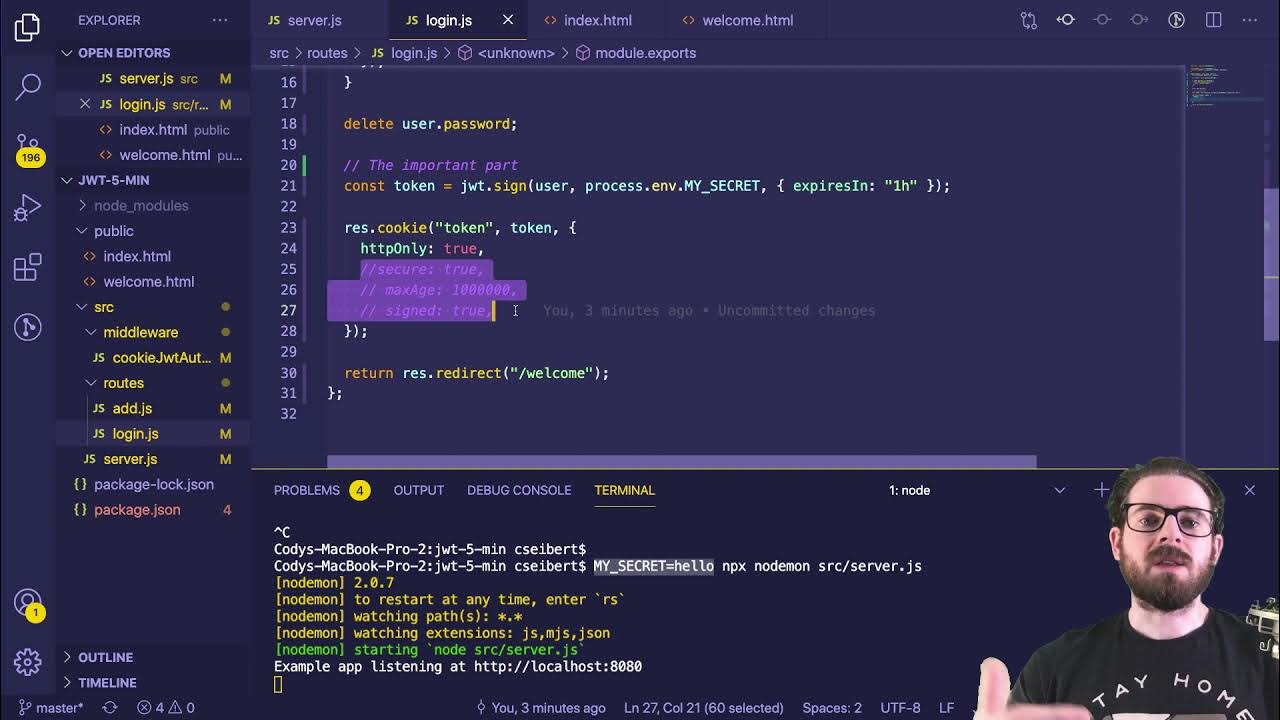Authentication Bypass Via JWK Header Injection
Summary
TLDRIn this video, the focus is on JWT (JSON Web Tokens) and a specific vulnerability—JWT Header Parameter Injection. The video first explains JWT structure, covering key components like header, payload, and signature, and introduces parameters such as 'kid,' 'jku,' and 'jwk.' The vulnerability allows attackers to inject a malicious JWK header, enabling them to forge a valid JWT. The presenter demonstrates exploiting this vulnerability, signing a token as an administrator to gain unauthorized access. Viewers are guided through the exploitation steps using tools like JWT editors and Burp Suite, highlighting potential security risks in JWT implementations.
Takeaways
- 😀 JWT (JSON Web Token) is a secure method for transmitting information, typically for authentication and authorization in web applications.
- 😀 A JWT consists of three parts: the header (metadata), the payload (claims and data), and the signature (used to verify authenticity).
- 😀 JWT tokens can include parameters like 'kid', 'jku', and 'jwk' that are essential for signing and verifying the token's integrity.
- 😀 The 'kid' parameter is a unique identifier for the key used to sign the JWT, helping the recipient choose the correct key from a set of available keys.
- 😀 The 'jku' parameter is a URL where the public key needed to verify the JWT signature can be fetched from.
- 😀 The 'jwk' parameter includes the actual public key in JSON format, directly within the JWT header.
- 😀 JWT tokens often use asymmetric encryption (public/private keys), where the private key signs the token and the public key verifies it.
- 😀 In asymmetric encryption, the private key is kept secret and used for signing/decrypting, while the public key is shared for verification/encryption.
- 😀 The video demonstrates a JWT authentication bypass attack using 'jwk header injection', where a custom JWT signature is injected to access the admin panel.
- 😀 By injecting a forged 'jwk' header and creating a new RSA key pair, the attacker can create a custom token that the server mistakenly accepts, granting unauthorized access to an admin panel.
Q & A
What is a JWT (Json Web Token) and how is it used?
-A JWT is a secure way to transmit information between two parties, usually a client and a server. It is commonly used for authentication and authorization in web applications. A JWT consists of three parts: a header, payload, and signature.
What does the header of a JWT contain?
-The header of a JWT contains information about the token, such as the signing algorithm (e.g., RSA) and the key ID (kid). It specifies how the JWT is signed and how its authenticity is verified.
What is the role of the payload in a JWT?
-The payload of a JWT contains the data and claims about the user or entity, such as the username or user roles. This data is typically base64-encoded but is not encrypted, meaning it can be read by anyone who has the JWT.
What is the purpose of the signature in a JWT?
-The signature is used to verify the authenticity of the token. It ensures that the data within the JWT has not been tampered with by verifying the token with a key, often the public key corresponding to the private key used for signing.
What is the 'kid' parameter in a JWT header?
-The 'kid' parameter, or key ID, is a unique identifier for the key that was used to sign the JWT. It tells the recipient which key to use to verify the token's signature.
What does the 'jku' parameter in a JWT header represent?
-The 'jku' (Json Web Key Set URL) parameter is a URL where the recipient can fetch the public key needed to verify the JWT's signature. This URL hosts the keys.
What is the 'jwk' parameter in a JWT header?
-The 'jwk' (Json Web Key) parameter contains the actual public key in JSON format. This key can be used directly to verify the JWT signature, instead of fetching the key from a URL.
How does asymmetric encryption work in the context of JWT?
-Asymmetric encryption in JWT uses a pair of keys: a private key for signing the JWT and a public key for verifying it. The private key is kept secret by the owner, while the public key can be shared with anyone who needs to verify the JWT.
What is the potential vulnerability associated with JWT and the 'jwk' parameter?
-If a server accepts any public key for a particular private key, an attacker could create their own public-private key pair and inject it into the JWT's 'jwk' parameter. This would allow the attacker to sign their own token, potentially bypassing authentication.
How can an attacker exploit the 'jwk' header to bypass JWT authentication?
-An attacker can generate their own RSA key pair, modify the JWT to include their public key in the 'jwk' parameter, and then sign the token with their private key. If the server doesn't properly validate the public key, it may accept the forged token, allowing the attacker to gain unauthorized access, such as logging in as an administrator.
Outlines

このセクションは有料ユーザー限定です。 アクセスするには、アップグレードをお願いします。
今すぐアップグレードMindmap

このセクションは有料ユーザー限定です。 アクセスするには、アップグレードをお願いします。
今すぐアップグレードKeywords

このセクションは有料ユーザー限定です。 アクセスするには、アップグレードをお願いします。
今すぐアップグレードHighlights

このセクションは有料ユーザー限定です。 アクセスするには、アップグレードをお願いします。
今すぐアップグレードTranscripts

このセクションは有料ユーザー限定です。 アクセスするには、アップグレードをお願いします。
今すぐアップグレード関連動画をさらに表示

What is Json Web Token? JWT Token Explained

What Is JWT and Why Should You Use JWT

JWT authentication bypass via 'X-HTTP-Method-Override' Header

Learn JWT in 10 Minutes with Express, Node, and Cookie Parser

Session Vs JWT: The Differences You May Not Know!

JWT Authentication with Node.js, React, MySQL | Node JS Authentication With JSON Web Token
5.0 / 5 (0 votes)
